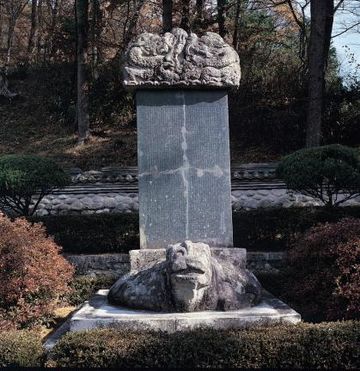합천 해인사 홍제암 사명대사탑 및 석장비
| 합천 해인사 홍제암 사명대사탑 및 석장비 Stupa and Stele of Buddhist Monk Samyeong at Hongjeam Hermitage of Haeinsa Temple, Hapcheon |
|
 합천 해인사 홍제암 사명대사탑 및 석장비, 국가문화유산포털, 문화재청. |
|
| 대표명칭 | 합천 해인사 홍제암 사명대사탑 및 석장비 |
|---|---|
| 영문명칭 | Stupa and Stele of Buddhist Monk Samyeong at Hongjeam Hermitage of Haeinsa Temple, Hapcheon |
| 한자 | 陜川 海印寺 弘濟庵 四溟大師塔 및 石藏碑 |
| 주소 | 경남 합천군 가야면 해인사길 154, 홍제암 |
| 지정번호 | 보물 제1301호 |
| 지정일 | 2000년 9월 28일 |
| 분류 | 유적건조물/종교신앙/불교/탑 |
| 시대 | 조선시대 |
| 수량/면적 | 2기 |
| 웹사이트 | 합천 해인사 홍제암 사명대사탑 및 석장비, 국가문화유산포털, 문화재청. |
|
|
|
해설문
국문
임진왜란 때 승장(僧將)으로 나라를 지킨 사명대사(四溟大師, 1544-1610)의 일대기를 기록한 비석과 사리를 봉안한 부도(浮屠)이다. 해인사의 부속암자인 홍제암(弘濟庵) 경내에 있다.
홍제암은 사명대사가 1608년에 선조의 하사로 창건하여 말년까지 수도하다 입적한 곳이다. 부도는 사명대사의 사리를 봉안한 석조물로 1610년에 만들어졌고, 비석은 1612년에 건립되었다가 1943년에 일본인에 의해 파괴된 것을 1958년에 복원하였다.
부도는 고려의 승탑(僧塔) 형식을 계승하여 3단의 연화대좌(蓮花臺座)와 종모양의 탑신(塔身), 둔중한 지붕돌을 갖추고 있다.
영문
Stupa and Stele of Buddhist Monk Samyeong at Hongjeam Hermitage of Haeinsa Temple, Hapcheon
These are the stupa and stele of the Buddhist monk Yujeong (1544-1610), also known as Master Samyeong. A stupa is a structure built to enshrine the relics or cremated remains of a Buddhist monk. A stele recording the monk's life and achievements was commonly erected together with the stupa.
Yujeong became a monk at the age of 16. During the Japanese invasions of 1592-1598, he played a key role in recapturing Pyeongyangseong Fortress. In 1604, he went to Japan with the king’s message to conclude negotiations for peace and returned with 3,000 Korean prisoners-of-war. In 1608, he built a thatched-roof hermitage at the current site of Hongjeam Hermitage, where he practiced the teachings of the Buddha until he died.
The stupa was built in the year of Yujeong's death. It consists of a two-tiered base, a bell-shaped body stone, and a decorative top shaped like a lotus bud.
The stele was erected in 1612. It is the earliest built among the extant steles honoring Yujeong. The epitaph was composed by Heo Gyun (1569-1618), a civil official and novelist, and records in detail the great events of Yujeong's life. In 1943, during the Japanese colonial period (1910-1945), the local Japanese police chief broke the stele into four pieces out of spite due to Yujeong's defense of Korea during the Japanese invasions. The stele was repaired to its current condition in 1958.
영문 해설 내용
조선시대의 승려 사명대사 유정(1544-1610)의 승탑과 그의 생애와 업적을 기리는 탑비이다. 승탑은 스님의 사리나 유골을 모셔 놓은 일종의 무덤이다. 스님의 사후에 승탑과 탑비가 함께 조성된다.
유정은 16세에 출가하였으며, 임진왜란 당시 평양성 탈환에 공을 세웠다. 1604년 국서를 가지고 왜로 건너가 강화를 체결하고 조선인 포로 3천여 명을 데리고 돌아오기도 하였다. 1608년 지금의 홍제암 자리에 초가 암자를 짓고 수도하다가 1610년 입적하였다.
사명대사탑은 사명대사가 입적한 바로 그 해에 조성되었다. 2층으로 된 기단, 종 모양의 몸돌, 연꽃 봉우리 모양의 머리장식으로 이루어져 있다.
석장비는 현존하는 사명대사비 중 가장 이른 시기인 1612년에 세워졌다. 비문은 문신이자 소설가였던 허균(1569-1618)이 지었으며, 사명대사의 일대기가 상세하게 기록되어 있다. 1943년 합천 경찰서장이었던 일본인이 네 조각으로 깨트렸던 것을 1958년에 복원하였다.
참고 자료
- 문화콘텐츠닷컴 http://www.culturecontent.com/content/contentView.do?content_id=cp052801780001 - 사명대사 일대기 정리
- 오마이뉴스 2008.3.19. 기사 http://www.ohmynews.com/NWS_Web/View/at_pg.aspx?CNTN_CD=A0000859082
- 전통사찰총서 20 - 경남의 전통사찰 3, 사찰문화연구원, 2005.
- 문화재청 국가문화유산포털 http://www.heritage.go.kr/heri/cul/culSelectDetail.do?VdkVgwKey=12,13010000,38&pageNo=1_1_1_0
- 석장비 및 부도 관련 추가 스토리(신빙성은 없는 듯) https://yahoe.tistory.com/2461
- 해인사 홍제암 실측조사보고서, 문화재청, 2004.
- https://m.blog.naver.com/PostView.nhn?blogId=drkdc&logNo=100194847298&proxyReferer=https%3A%2F%2Fwww.google.com%2F